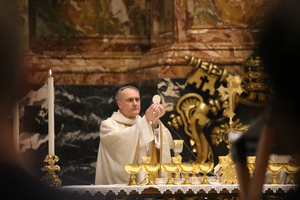What Happens on Holy Thursday?
What specifically happens during the liturgical events on Holy Thursday, and what do they represent?

Liturgically speaking, Holy Thursday is one of my favorite days of the year. It begins the Paschal Triduum — the three days leading up to Easter — and commemorates the institution of two sacraments: Holy Orders and the Holy Eucharist. The beauty of Holy Thursday reveals itself in the liturgical events, as they are steeped in much symbolism. They beckon us to live the sacred mysteries of the Church and of Christ’s Passion in a deeper way.
So, what specifically happens during the liturgical events on Holy Thursday, and what do they represent?
The Chrism Mass
Generally taking place the morning of Holy Thursday, priests throughout each diocese travel to their local diocesan cathedral to concelebrate the Chrism Mass. The clergy present renew the vows they made at their ordination, pledging obedience to their bishop. This act demonstrates the unity of the local churches, who are led by the bishop. Similarly, the Chrism Mass symbolizes the unity of the universal Church, as each bishop throughout the world consecrates three oils: the oil of the catechumens, the oil of the infirm and sacred chrism. These oils will then be carried back by the priests to their individual parishes, where they will be used for the baptisms, anointings, confirmations, ordinations and dedications of altars and churches during the year. The blessed oils bear a significant role in the life of the Church — in the words of Benedict XVI, they “hold together the entire liturgical year, anchored in the mystery of Holy Thursday.”
Mass of the Lord’s Supper
Two characteristics mark the last Mass until the Easter Vigil: the singing of the Gloria and the washing of the feet (though this rite may be omitted). Though the tabernacle is empty at the end of Mass, the first half of the liturgy exudes a sense of joy. The day commemorates the institution of the sacraments of Holy Orders and the Holy Eucharist — the celebrants are clothed in white vestments and the bells magnificently ring as the Gloria resounds throughout the church. After the homily, the atmosphere shifts to one of solemnity. The washing of the feet, if taking place, recalls Christ’s humble act of service before the events of the Passion commence.
As the Mass progresses, the words of the consecration are uttered for the last time until the Easter Vigil, and the bells that normally ring during the consecration are silenced and replaced by wood clappers. After Holy Communion, the Blessed Sacrament is placed in a ciborium and processed to a separate area of the church or another building while the Pange Lingua is sung. This symbolizes Christ’s journey to the Garden of Gethsemane, which we accompany him.
The Repository
Arriving at the altar of repose, the celebrant places the ciborium upon the altar, or in the tabernacle. There the Blessed Sacrament may remain reserved for adoration for several hours, usually until midnight. Flowers and plants adorn the sacred space, evoking images of a garden. During this time, we are invited to spend some moments in quiet adoration, recalling the words Christ spoke to his apostles in the Garden of Gethsemane (Matthew 14:27): “Could you not watch one hour?”
The Stripping of the Altars
Upon returning from the altar of repose, the celebrants exchange their white vestments for purple stoles. They then strip the high altar, symbolic of Christ being stripped of His garments. Psalm 22 is intoned: “My God, My God, why have you abandoned Me.” Traditionally — though the practice is currently omitted — the celebrants would wash the altar with a hyssop branch, dipped in water and wine, representing the preparation of Christ’s body for burial. The empty tabernacle and barren altar serve as a stark reminder that the Church is in mourning. Christ has entered his Passion. The sanctuary remains devoid of Christ’s presence until the Easter Vigil.
The Seven Churches Pilgrimage
Throughout the night, we can participate in an ancient practice of visiting seven churches and praying at each altar of repose. This tradition, known as the Seven Churches Pilgrimage, is believed to have originated in Rome from St. Philip Neri. As with any pilgrimage, the outward act of visiting seven different churches represents an inner journey. By partaking in this ancient devotion, we are called to inwardly accompany Christ in his Passion, meditating upon seven different aspects of the Passion from the duration of his arrest in the Garden to his crucifixion. Traditionally the seven “stations” are:
- The Agony of the Garden
- Christ bound and brought before Annas
- Christ brought to Caiaphas
- Christ brought to Pilate
- Christ brought to Herod
- Christ brought to Pilate where he is scourged, crowned with thorns and condemned to death, and
- Christ’s Via Crucis and crucifixion.
Some dioceses offer resources for making the Seven Churches Visitation, so check your diocesan website, or just plan your own!
By understanding the liturgical events in which we participate in on Holy Thursday, we can enter more deeply into the mysteries of the Triduum, and truly live these sacred mysteries.
Maria Cintorino writes from Virginia.
- Keywords:
- holy thursday















